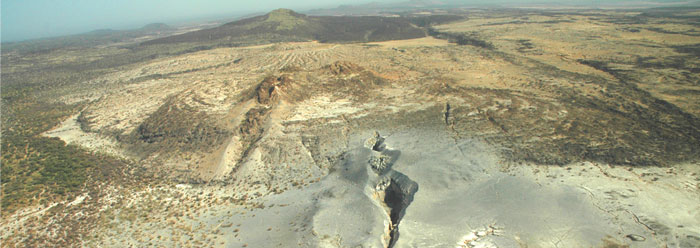Volcanic activity in 2005 accompanied the formation of a deep, wide rift in Ethiopia on part of the 4,000-mile-long north-to-south trending Great Rift Valley fault. Studies show that the injection of mantle material that “unzipped” the earth along the fault operated the same way as similar material does in less-accessible undersea rifts. Scientists knew that rifts were formed in this manner, but the suddenness of this one’s formation astonished them.
Cindy Ebinger, professor at the University of Rochester and co-author of a recent study on the rift, expressed in a university press release her surprise at how quickly the trench rifted. Ebinger said, “We know that seafloor ridges are created by a similar intrusion of magma into a rift, but we never knew that a huge length of the ridge could break open at once like this.”1
Taking this as a model for the crustal rifting that occurs deep under oceans, Ebinger and lead author Atalay Ayele, a professor at Addis Abbaba University in Ethiopia, suggested in the journal Geophysical Research Letters that “tectonic ocean plates may suddenly break apart in large sections, instead of little by little as has been predominantly believed.”1 Their observations in Ethiopia’s Afar Desert directly challenge the outdated uniformitarian interpretation of earth processes, which holds that slow and gradual processes formed earth’s features. Apparently, this belief was rooted in ideology, not observation.
The 2005 event was similar to a 2007 event in the Natron rift, from Kenya’s portion of the Great Rift Valley. In August of that year alone, the fault widened by 5.7 centimeters.2
The purpose of this new analysis of 2005 data was, according to Ebinger, “to learn whether what is happening in Ethiopia is like what is happening at the bottom of the ocean where it’s almost impossible for us to go….we now know that the answer is yes, it is analogous.” The mid-ocean ridges consist of many narrow rifts that are each hundreds of miles long. Based on the observed events in Ethiopia, “each one of those segments [rifts] can tear open in a just a few days.”1
The rapidity with which crustal movements are now known to occur lend even more credibility to the Catastrophic Plate Tectonics model proposed by researcher John Baumgardner.3 This model has been shown to be theoretically plausible using standard physics parameters, including temperature, and rock composition and pliability. It demonstrates numerically how earth’s ocean plates moved rapidly across the earth’s surface and were recycled into the earth's interior in mere months, rather than the millions of years assumed in the evolutionary model.
Now, accumulating evidence of rapid rifting―huge seams that open in perhaps days―contradicts the uniformitarian gradualism popularized by geologist Charles Lyell and naturalist Charles Darwin 150 years ago and still held by many modern geologists. In contrast, the observations fit the Catastrophic Plate Tectonics model, and that model fits in a biblically-consistent history for the earth.
References
- African Desert Rift Confirmed as New Ocean in the Making. University of Rochester press release, November 2, 2009, accessed November 4, 2009. Reporting research published in Ayele, A. et al. 2009. September 2005 mega-dike emplacement in the Manda-Harraro nascent oceanic rift (Afar depression). Geophysical Research Letters. 36, L20306.
- Thomas, B. Did Magma Dykes Spread the Continents? ICR News. Posted on icr.org December 19, 2008, accessed November 4, 2009.
- Austin, S. A. et al. 1994. Catastrophic Plate Tectonics: A Global Flood Model of Earth History. Proceedings of the Third International Conference on Creationism, R. E. Walsh, ed., Pittsburgh, PA: Creation Science Fellowship, Inc., 609–621.
Image Credit: University of Rochester
* Mr. Thomas is Science Writer at the Institute for Creation Research.
Article posted on November 18, 2009.




